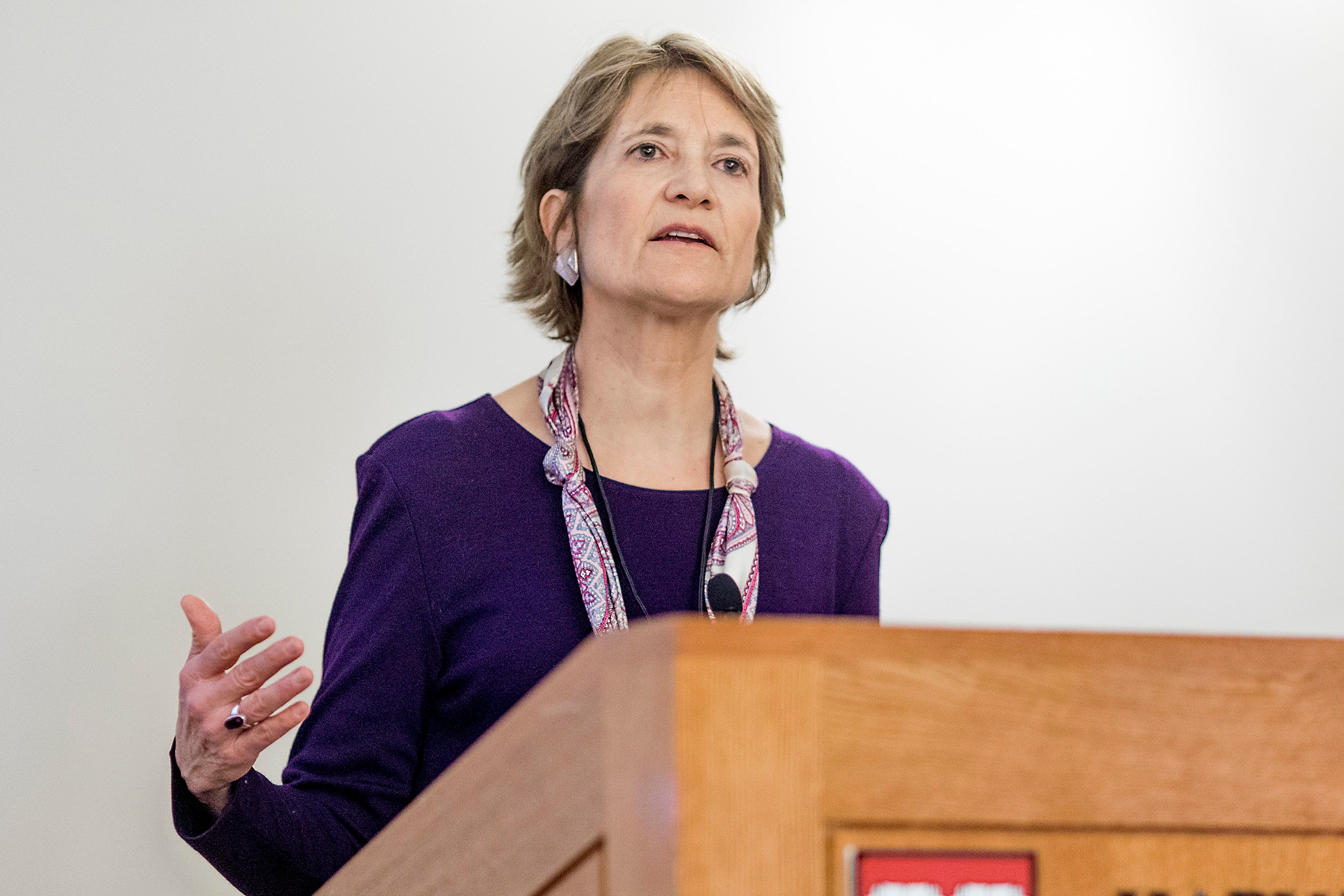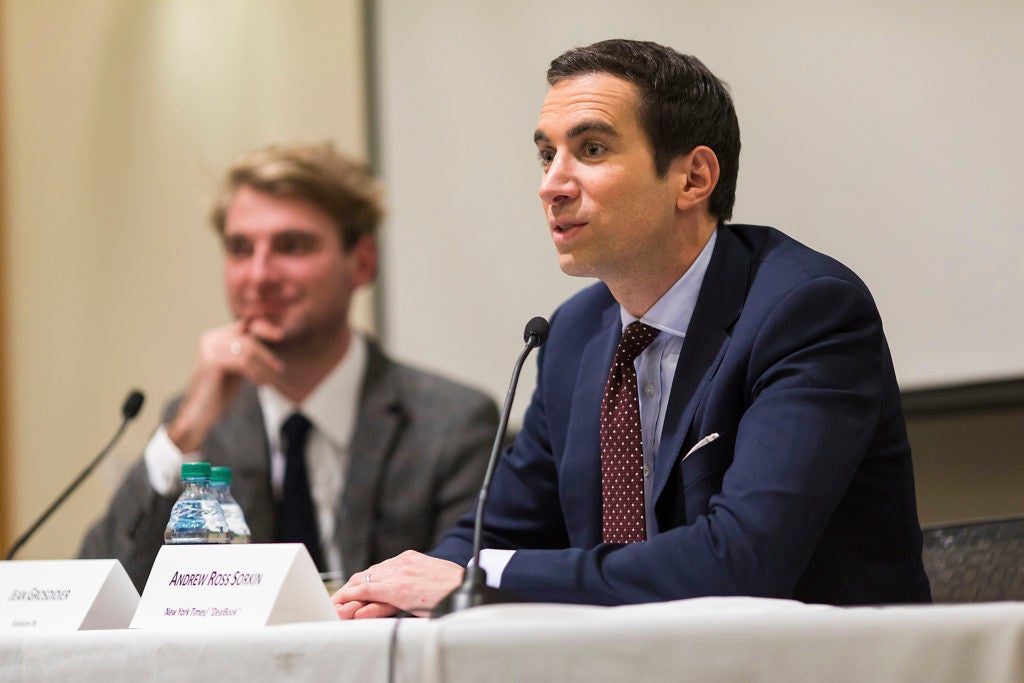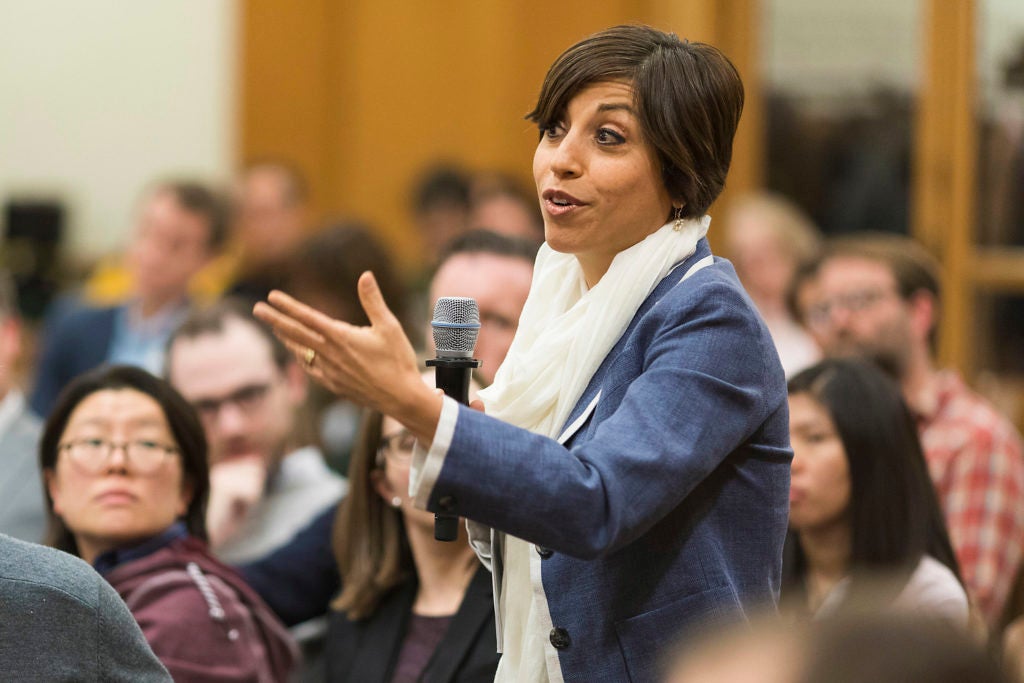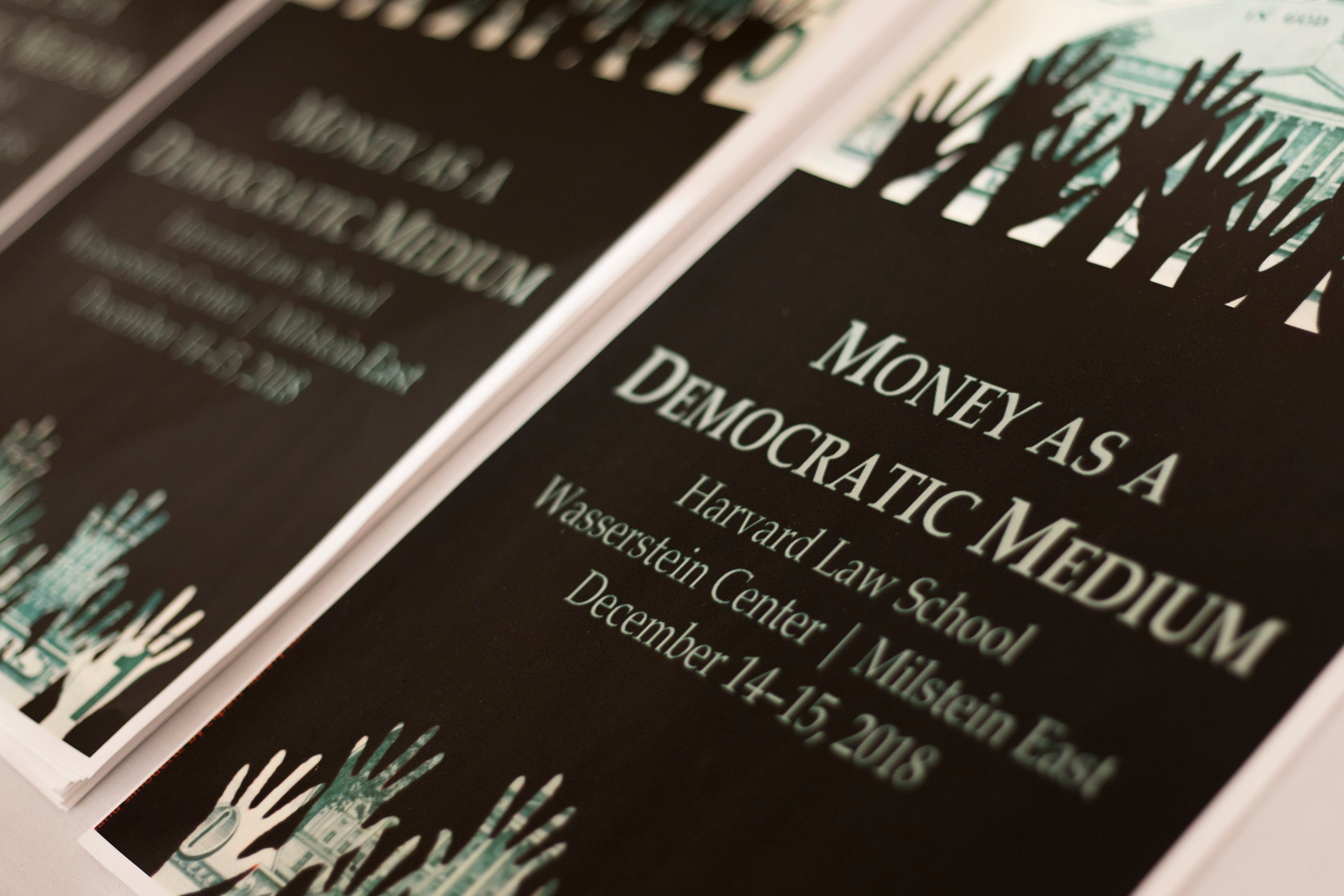Harvard’s recent two-day conference, “Money as a Democratic Medium,” challenged its participants to re-examine the history of money in America, and to redefine its future. The event was jointly sponsored by the Harvard Program on the Study of Capitalism, the Murphy Institute at Tulane University, the Harvard Law Forum and Harvard Law School, bringing a diverse group of lawyers, economists, academics and scholars to the HLS campus.

In her opening remarks, organizer and HLS professor Christine Desan contrasted traditional assumptions that money came into existence through social consensus with the more recent recognition that money is a medium engineered by governments out of sovereign debt (see sidebar). “If money is by nature democratic, that implies that the market is similarly democratic. But if money is sovereign debt, as it clearly is in the modern world, then we have some more thinking to do. Money was redefined after the Civil War, not once but several times. We created a national banking system, we established the Federal Reserve, we created institutions that determine how money enters circulation. So the issue is: How can we design money so that it–and the market it makes–will inform and perpetuate democracy?”
The ways in which money has failed democracy were discussed in a morning panel, “Financialization and Inequality.” The game has largely changed since the 1970s, said Financial Times editor Rana Foroohar. “Finance has taken a lot more of the corporate profit pie. The most striking figure I found in my research was where the financial flows went. Only about 15 percent of the money flowing out of [large financial] institutions was going to new businesses—The rest was a closed loop of the buying and selling of its own assets.” Thus, she said, the majority of corporate money is still held abroad, despite the Trump administration’s promises that its recent tax cuts would bring that money home for investment. “The solution is to change the narrative. We should be pulling back and asking, ‘What kind of financial system do we want to have? And how do we create a system to serve the real economy?’”
Foroohar noted that when the Dodd-Frank Act for Wall Street reform was passed in 2010, the government negotiated almost entirely with bankers. “I asked an Obama official how you could say the system is being fairly regulated, when 96 percent of the meeting is taken up by the banks being regulated. He looked at me with real befuddlement and said, ‘Who else should we be talking to?’”
Gerald Epstein, of the University of Massachusetts—Amherst, said that the rise of finance coincided with that of inequality, creating a system that favors some citizens over others. “Underlying all of this is a process by which wealth generates political power, to further this wealth and equality.” The country, he said, is now run by a “bankers’ club” that includes elected officials who get campaign contributions from banks, central banks that make decisions on whom to bail out, and regulatory authorities and lawyers “who do the bidding of these elites to try and rewrite rules.” Recent political upheavals, he said, display both the strength and the vulnerability of this club. “Trump manipulated the anger at the political elite. The first thing he did when he got into power was financial deregulation, and the anger is still there.” One solution Epstein offered was to reform campaign financing. “That would make money more democratic, since money could no longer be used to buy democracy.”
Other panels proposed further, concrete solutions aimed at democratizing money. In a keynote speech Friday afternoon, author Andrew Ross Sorkin (Too Big To Fail) discussed a proposal that he’s advocated in a recent series of New York Times opinion pieces that credit-card companies prevent mass shootings by denying funding of gun sales. As the first of these pieces argued in February, financial corporations have a moral responsibility to confront social challenges when Washington won’t.
Credit is more integral to mass shootings than many people realize, he noted on Friday. “The idea that these shootings are the provenance of black markets is false,” he said. The amount of hardware that is usually involved— military-grade weapons, bulletproof jackets, and stockpiles of ammunition—is freely available and normally costs in the tens of thousands. The perpetrator of the Las Vegas shooting accumulated $30,000 worth of weaponry over a year, using multiple credit cards. “These people know what they’re doing. You need to be a well-financed individual and instead of a terrorist organization, you have Visa and MasterCard who are financing these shootings.”
There are already restrictions on what credit cards can and can’t do, Sorkin said: They can’t be used for illegal transactions like prostitution, nor for marijuana sales (even in states where it’s legal), and 21 states don’t allow credit cards for lottery tickets. And certain smaller services, including Apple Pay and PayPal, already prohibit gun sales. “We have made decisions as a democracy, in terms of what we want our payment systems to do. So there is room here for people concerned about guns to actually make a difference.” But despite popular support for gun control, this isn’t a decision that the current government is likely to make. “If the industry won’t make this change voluntarily, the federal level would be the easiest way to do it. But in this day and age, that’s also the hardest way.”

Sorkin acknowledged that there would be obstacles to his proposal. For one thing, WalMart and other stores selling guns don’t reveal to the credit companies the specific items that are purchased in transactions, so this system would need to be revamped. But the bigger problem is that credit card companies are apparently reluctant to touch the issue. Asked what their response has been to his articles, Sorkin replied that “I’ve spoken to many of them, and in my columns they decline to comment. To be fair I think many of them are scared on this issue. It’s such a hot potato that they won’t speak publicly.”
Saturday’s morning plenary session, “The Public Option and a Narrow Bank,” examined a controversial proposal made by Morgan Ricks of Vanderbilt University Law School and co-authors John Crawford and Lev Menand: Earlier this year Ricks proposed that the Federal Reserve, which currently acts as a central bank doing business only with commercial banks, offer banking directly to all U.S. citizens. In his paper, “Central Banking for All,” Ricks outlines the advantages that would result: Citizens would be spared fees on their transactions and debit cards, and they’d receive the Federal interest rate (currently close to two percent) that commercial banks aren’t passing on to customers.
After Ricks presented his argument, a panel including Harvard Economics Department chair Jeremy Stein debated it. “The benefits would be astonishing,” Ricks said. “If everybody had a fed account, they’d get monthly statements and debit cards, but they’d also have the benefits that banks currently enjoy—higher interest, and the unlimited sovereign nature of the claim. And the most obvious benefit would be financial inclusion. Seven percent of the U.S. population is currently unbanked, and the lack of fees and minimum deposits would be a real boon to bringing people in.” The Fed in turn would get an influx of money from that seven percent opening new accounts. The key objections, he said, hinge on the Fed’s potential inability to deal with cybersecurity, fraud prevention, and privacy/civil liberties issues. “All of these concerns are real, but they are manageable and easily overstated.”
Stein said that he was on board with Ricks’ underlying premise, and agreed that “private banks tend to treat their depositors pretty shabbily.” But he underlined the enormity of the Fed’s task in taking on so many theoretical new accounts. In a modest scenario, the Fed would absorb an estimated $10 trillion in private bank accounts, which it would then need to lend back to the banks so that they’d survive. A larger option is for the Fed to take over all short-term money provision, bearing substantially more credit risk. Effectively, the Fed would now be insuring the entire U.S. financial system. “In my wildest dreams of being a financial banker, I would not want this job,” Stein said.

The third panelist, former Federal Reserve official James McAndrews, has proposed a somewhat similar alternative to Ricks’ idea, a private sector “narrow bank” that would not make loans but would pass its customers’ deposits onto the Fed, and convey the higher interest rate back to the customers. The plan for this bank, known as TNB USA, was recently blocked by the Fed, and McAndrews has filed a lawsuit to challenge that decision. As noted in a recent New York Times piece, critics of McAndrews’ proposal have claimed that narrow banks would destabilize the financial system by drawing customers from existing banks. McAndrews has argued that narrow banking already exists, as the Fed offers opportunities to a number of financial institutions and foreign banks to park money at the Fed in return for an interest payment.
“We have been living in a narrow bank world for years,” McAndrews said. He argued that the creation of TNB USA would strengthen competition in the deposit market and improve financial stability. “The time has come to allow the formation of private sector narrow banks, and I am urging the Federal reserve to consider this.”
According to Saturday’s keynote talk by Mehrsa Baradaran of the University of Georgia Law School, the financial deck has been stacked against black people since the days of slavery. Drawing from her recent book “The Color of Money: Black Banks and the Racial Wealth Gap,” Baradaran’s talk traced a history that has denied equal financial opportunity to blacks, offering self-help homilies in its place.
“The rhetoric of free-market capitalism was used against them, and self-help was offered as a decoy,” she said. “The promise of free-market capitalism is that it does not discriminate, and yet history reveals that markets do discriminate. For most of our history, blacks have been excluded from schools and trades, and their finances have not been protected by law. The color of money, for much of U.S. history, was white.”
She traced that history back to the slavery-era economy—in which slaves were depicted on Confederate bills—and to the establishment of the Freedman’s Savings Bank afterward. The government encouraged newly-freed blacks to invest in the bank, not pointing out that it hadn’t been government insured; the bank’s white manager in fact lost much of the money on railroad bonds. “Instead of getting land, the freed slaves got a bank,” Baradaran said. “The notes and the building still had government insignia, but it was really a glorified piggy bank. By the time the Freedman’s Bank failed, the disenfranchisement of the black population was complete.” Indeed, she said, many Southern blacks still distrusted banks because of the Freedman episode as recently as her research in 2014.
The selling of black self-help rather than actual government assistance persisted well into the ‘60s and beyond. As the heyday of civil rights wound down, President Nixon championed black capitalism, but this largely amounted to lip service, said Baradaran. “To see how great a diversion this was, you have to look at the path not taken. George Romney pushed hard for integration; Nixon fought him every step of the way. There was a bipartisan bill for reparation through Treasury deposits, and he killed that. Instead he deposited millions of dollars into black banks with much fanfare; and he created the Office of Minority Business Enterprise, which cannibalized Johnson’s poverty program. Black capitalism was an anemic response to the needs of the black community, but it was an effective decoy.”
More recently, she said, subprime loans were disproportionately given to the black community, so it was hit especially hard in the 2007-08 financial crisis. Yet the rhetoric of black capitalism has endured; most recently with the Treasury naming a wing after the Freedman’s Bank. “There are stubborn, longstanding myths that small community banks are the remedy in marginalized communities. I blame Thomas Jefferson for starting this myth and George Bailey for perpetuating it,” she said, naming the hero of It’s a Wonderful Life. “I propose we all boycott the movie next year.”
